Terahertz Inspection of Buildings and Architectural Art
Abstract
1. Introduction
- It penetrates a broad selection of materials, including textiles, polymers, ceramics, pigments, wood, etc.
- It is non-ionizing, therefore it represents no occupational hazard to the users of this technology, and to the chemical, and therefore aesthetic, integrity of artworks.
- It can produce cross-sectional images of layered structures, such as the ones present in multi-layer paintings.
Overview of Terahertz Technology
2. Terahertz Uses in Architectural Art
2.1. Wall Paintings
2.2. Stone Artwork
2.3. Stucco Reliefs
2.4. Clay Decorations
2.5. Paint on Metal Structures
3. Structural Integrity Inspection Of Buildings
4. Monitoring of the Conservation Process of a Mural
5. Final Remarks
Author Contributions
Funding
Acknowledgments
Conflicts of Interest
References
- Dhillon, S.; Vitiello, M.; Linfield, E.; Davies, A.; Hoffmann, M.C.; Booske, J.; Paoloni, C.; Gensch, M.; Weightman, P.; Williams, G.; et al. The 2017 terahertz science and technology roadmap. J. Phys. D Appl. Phys. 2017, 50, 043001. [Google Scholar] [CrossRef]
- Wehrenfennig, C.; Eperon, G.E.; Johnston, M.B.; Snaith, H.J.; Herz, L.M. High charge carrier mobilities and lifetimes in organolead trihalide perovskites. Adv. Mater. 2014, 26, 1584–1589. [Google Scholar] [CrossRef] [PubMed]
- Kindt, J.; Schmuttenmaer, C. Far-infrared dielectric properties of polar liquids probed by femtosecond terahertz pulse spectroscopy. J. Phys. Chem. 1996, 100, 10373–10379. [Google Scholar] [CrossRef]
- Castro-Camus, E.; Palomar, M.; Covarrubias, A. Leaf water dynamics of Arabidopsis thaliana monitored in-vivo using terahertz time-domain spectroscopy. Sci. Rep. 2013, 3, 1–5. [Google Scholar] [CrossRef]
- Zeitler, J.A.; Shen, Y.C. Industrial applications of terahertz imaging. In Terahertz Spectroscopy and Imaging; Springer: Berlin/Heidelberg, Germany, 2012; pp. 451–489. [Google Scholar]
- Fukunaga, K. Thz Technology Applied to Cultural Heritage in Practice; Springer: Berlin/Heidelberg, Germany, 2016. [Google Scholar]
- Smith, P.R.; Auston, D.H.; Nuss, M.C. Subpicosecond photoconducting dipole antennas. IEEE J. Quantum Electron. 1988, 24, 255–260. [Google Scholar] [CrossRef]
- Grischkowsky, D.; Keiding, S.; Van Exter, M.; Fattinger, C. Far-infrared time-domain spectroscopy with terahertz beams of dielectrics and semiconductors. JOSA B 1990, 7, 2006–2015. [Google Scholar] [CrossRef]
- Jepsen, P.U.; Cooke, D.G.; Koch, M. Terahertz spectroscopy and imaging—Modern techniques and applications. Laser Photonics Rev. 2011, 5, 124–166. [Google Scholar] [CrossRef]
- Hu, B.B.; Nuss, M.C. Imaging with terahertz waves. Opt. Lett. 1995, 20, 1716–1718. [Google Scholar] [CrossRef]
- Chan, W.L.; Deibel, J.; Mittleman, D.M. Imaging with terahertz radiation. Rep. Prog. Phys. 2007, 70, 1325. [Google Scholar] [CrossRef]
- Stubling, E.M. Entwicklung und Charakterisierung eines Roboter-Basierten Terahertz- Zeitbereichsspektrometers für Bildgebende Anwendungen auf dem Gebiet der Anthropologie und Kunstrestaurierung. Ph.D. Thesis, Philipps-Universität Marburg, Marburg, Germany, 2019. [Google Scholar]
- Wilk, R.; Mikulics, M.; Biermann, K.; Künzel, H.; Kozma, I.Z.; Holzwarth, R.; Sartorius, B.; Mei, M.; Koch, M. THz time-domain spectrometer based on LT-InGaAs photoconductive antennas exited by a 1.55 μm fibre laser. In Proceedings of the Conference on Lasers and Electro-Optics, Optical Society of America, Baltimore, MD, USA, 6–11 May 2007; p. CThR2. [Google Scholar]
- Stübling, E.M.; Rehn, A.; Siebrecht, T.; Bauckhage, Y.; Öhrström, L.; Eppenberger, P.; Balzer, J.C.; Rühli, F.; Koch, M. Application of a robotic THz imaging system for sub-surface analysis of ancient human remains. Sci. Rep. 2019, 9, 1–8. [Google Scholar] [CrossRef]
- Hernandez-Cardoso, G.; Rojas-Landeros, S.; Alfaro-Gomez, M.; Hernandez-Serrano, A.; Salas-Gutierrez, I.; Lemus-Bedolla, E.; Castillo-Guzman, A.; Lopez-Lemus, H.; Castro-Camus, E. Terahertz imaging for early screening of diabetic foot syndrome: A proof of concept. Sci. Rep. 2017, 7, 42124. [Google Scholar] [CrossRef] [PubMed]
- Mittleman, D.M.; Hunsche, S.; Boivin, L.; Nuss, M.C. T-ray tomography. Opt. Lett. 1997, 22, 904–906. [Google Scholar] [CrossRef]
- Schmitt, J.M. Optical coherence tomography (OCT): A review. IEEE J. Sel. Top. Quantum Electron. 1999, 5, 1205–1215. [Google Scholar] [CrossRef]
- Stübling, E.; Bauckhage, Y.; Jelli, E.; Fischer, B.; Globisch, B.; Schell, M.; Heinrich, A.; Balzer, J.; Koch, M. A THz tomography system for arbitrarily shaped samples. J. Infrared Millim. Terahertz Waves 2017, 38, 1179–1182. [Google Scholar] [CrossRef]
- Stubbs, J.H.; Makaš, E.G. Architectural Conservation in Europe and the Americas; John Wiley & Sons: Hoboken, NJ, USA, 2011. [Google Scholar]
- Kennedy, C.J. The role of heritage science in conservation philosophy and practice. Hist. Environ. Policy Pract. 2015, 6, 214–228. [Google Scholar] [CrossRef]
- Aubert, M.; Lebe, R.; Oktaviana, A.A.; Tang, M.; Burhan, B.; Jusdi, A.; Hakim, B.; Zhao, J.X.; Geria, I.M.; Sulistyarto, P.H.; et al. Earliest hunting scene in prehistoric art. Nature 2019, 576, 442–445. [Google Scholar] [CrossRef]
- Insall, D.W.; Larson, J. Art Conservation and Restoration—Wall Paintings. Available online: https://www.britannica.com/art/art-conservation-and-restoration/Paintings-on-ivory (accessed on 10 March 2020).
- Walker, G.C.; Jackson, J.B.; Giovannacci, D.; Bowen, J.W.; Delandes, B.; Labaune, J.; Mourou, G.; Menu, M.; Detalle, V. Terahertz analysis of stratified wall plaster at buildings of cultural importance across Europe. In Proceedings of the Optics for Arts, Architecture, and Archaeology IV. International Society for Optics and Photonics, Munich, Germany, 15–16 May 2013; Volume 8790, p. 87900H. [Google Scholar]
- Jackson, J.; Mourou, M.; Whitaker, J.; Duling, I., III; Williamson, S.; Menu, M.; Mourou, G. Terahertz imaging for non-destructive evaluation of mural paintings. Opt. Commun. 2008, 281, 527–532. [Google Scholar] [CrossRef]
- Fukunaga, K.; Hosako, I.; Kohdzuma, Y.; Koezuka, T.; Kim, M.J.; Ikari, T.; Du, X. Terahertz analysis of an East Asian historical mural painting. J. Eur. Opt. Soc.-Rapid Publ. 2010, 5. [Google Scholar] [CrossRef]
- Walker, G.C.; Bowen, J.W.; Matthews, W.; Roychowdhury, S.; Labaune, J.; Mourou, G.; Menu, M.; Hodder, I.; Jackson, J.B. Sub-surface terahertz imaging through uneven surfaces: Visualizing Neolithic wall paintings in Çatalhöyük. Opt. Express 2013, 21, 8126–8134. [Google Scholar] [CrossRef]
- Fukunaga, K.; Meldrum, T.; Zia, W.; Ohno, M.; Fuchida, T.; Blümich, B. Nondestructive investigation of the internal structure of fresco paintings. In Proceedings of the 2013 Digital Heritage International Congress (DigitalHeritage), Marseille, France, 28 October–1 November 2013; IEEE: Piscataway, NJ, USA, 2013; Volume 1, pp. 81–88. [Google Scholar]
- ACS. Ancient Roman Man Hidden Beneath Famous Painting at the Louvre, ScienceDaily. Available online: http://www.sciencedaily.com/releases/2013/04/130410154622.htm (accessed on 4 August 2015).
- Radpour, R.; Bajwa, N.; Garritano, J.; Sung, S.; Balonis-Sant, M.; Tewari, P.; Grundfest, W.; Kakoulli, I.; Taylor, Z. THz imaging studies of painted samples to guide cultural heritage investigations at the Enkleistra of St. Neophytos in Paphos, Cyprus. In Terahertz Emitters, Receivers, and Applications V; International Society for Optics and Photonics: San Diego, CA, USA, 2014; Volume 9199, p. 91990Q. [Google Scholar]
- Inuzuka, M.; Kouzuma, Y.; Sugioka, N.; Fukunaga, K.; Tateishi, T. Investigation of layer structure of the takamatsuzuka mural paintings by terahertz imaging technique. J. Infrared Millim. Terahertz Waves 2017, 38, 380–389. [Google Scholar] [CrossRef]
- Dandolo, C.L.K.; Jepsen, P.U. Wall painting investigation by means of non-invasive terahertz time-domain imaging (THz-TDI): Inspection of subsurface structures buried in historical plasters. J. Infrared Millim. Terahertz Waves 2016, 37, 198–208. [Google Scholar] [CrossRef]
- Catapano, I.; Ludeno, G.; Cucci, C.; Picollo, M.; Stefani, L.; Fukunaga, K. Noninvasive Analytical and Diagnostic Technologies for Studying Early Renaissance Wall Paintings. Surv. Geophys. 2019, 41, 669–693. [Google Scholar] [CrossRef]
- Schwerdtfeger, M.; Castro-Camus, E.; Krügener, K.; Viöl, W.; Koch, M. Beating the wavelength limit: Three-dimensional imaging of buried subwavelength fractures in sculpture and construction materials by terahertz time-domain reflection spectroscopy. Appl. Opt. 2013, 52, 375–380. [Google Scholar] [CrossRef] [PubMed]
- Krügener, K.; Schwerdtfeger, M.; Busch, S.F.; Soltani, A.; Castro-Camus, E.; Koch, M.; Viöl, W. Terahertz meets sculptural and architectural art: Evaluation and conservation of stone objects with T-ray technology. Sci. Rep. 2015, 5, 1–7. [Google Scholar] [CrossRef] [PubMed]
- Ching, M.C.H.; Giovannacci, D.; Gariani, G.; Brissaud, D.; Leroux, L.; Goubard, F.; Bouquillon, A.; Bormand, M. 3D internal reconstruction by the use of terahertz time domain imaging (THz-TDI): An application on a 15th century stucco relief. In Optics for Arts, Architecture, and Archaeology VI; International Society for Optics and Photonics: San Diego, CA, USA, 2017; Volume 10331, p. 103310K. [Google Scholar]
- Krügener, K.; Busch, S.F.; Soltani, A.; Castro-Camus, E.; Koch, M.; Viöl, W. Non-destructive analysis of material detachments from polychromatically glazed terracotta artwork by THz time-of-flight spectroscopy. J. Infrared Millim. Terahertz Waves 2017, 38, 495–502. [Google Scholar] [CrossRef]
- Lambert, F.; Reyes-Reyes, E.; Hernandez-Cardoso, G.; Gomez-Sepulveda, A.; Castro-Camus, E. In situ Determination of the State of Conservation of Paint Coatings on the Kiosk of Guadalajara Using Terahertz Time-Domain Spectroscopy. J. Infrared Millim. Terahertz Waves 2020, 41, 355–364. [Google Scholar] [CrossRef]
- Abina, A.; Puc, U.; Jeglič, A.; Zidanšek, A. Applications of terahertz spectroscopy in the field of construction and building materials. Appl. Spectrosc. Rev. 2015, 50, 279–303. [Google Scholar] [CrossRef]
- Dash, J.; Ray, S.; Nallappan, K.; Sasmal, S.; Pesala, B. Non-destructive inspection of internal defects in concrete using continuous wave 2D terahertz imaging system. In Proceedings of the 2013 38th International Conference on Infrared, Millimeter and Terahertz Waves (IRMMW-THz), Mainz, Germany, 1–6 September 2013; IEEE: Piscataway, NJ, USA, 2013; pp. 1–2. [Google Scholar]
- Oyama, Y.; Zhen, L.; Tanabe, T.; Kagaya, M. Sub-terahertz imaging of defects in building blocks. Ndt E Int. 2009, 42, 28–33. [Google Scholar] [CrossRef]
- Piesiewicz, R.; Jansen, C.; Wietzke, S.; Mittleman, D.; Koch, M.; Kürner, T. Properties of building and plastic materials in the THz range. Int. J. Infrared Millim. Waves 2007, 28, 363–371. [Google Scholar] [CrossRef]
- Piesiewicz, R.; Kleine-Ostmann, T.; Krumbholz, N.; Mittleman, D.; Koch, M.; Kürner, T. Terahertz characterisation of building materials. Electron. Lett. 2005, 41, 1002–1004. [Google Scholar] [CrossRef]
- Tanabe, T.; Kanai, T.; Kuroo, K.; Nishiwaki, T.; Oyama, Y. Non-contact Terahertz Inspection of Water Content in Concrete of infrastructure buildings. World J. Eng. Technol. 2018, 6, 275–281. [Google Scholar] [CrossRef]
- Federici, J.F. Review of moisture and liquid detection and mapping using terahertz imaging. J. Infrared Millim. Terahertz Waves 2012, 33, 97–126. [Google Scholar] [CrossRef]
- Cacciari, I.; Siano, S. Use of THz Reflectometry for roughness estimations of archeological metal surfaces. J. Infrared Millim. Terahertz Waves 2017, 38, 503–517. [Google Scholar] [CrossRef]
- Jackson, J.B.; Labaune, J.; Bailleul-Lesuer, R.; D’Alessandro, L.; Whyte, A.; Bowen, J.W.; Menu, M.; Mourou, G. Terahertz pulse imaging in archaeology. Front. Optoelectron. 2015, 8, 81–92. [Google Scholar] [CrossRef]
- Riedl, N. Wandmalerei in freier Bewitterung. Konservatorische Herausforderungen am UNESCO- Weltkulturerbe Konstantinbasilika Trier–eine Einführung. ICOMOS—Hefte des Deutschen Nationalkomitees 2013, 55, 12–20. [Google Scholar]
- Dong, J.; Locquet, A.; Melis, M.; Citrin, D. Global mapping of stratigraphy of an old-master painting using sparsity-based terahertz reflectometry. Sci. Rep. 2017, 7, 1–12. [Google Scholar] [CrossRef]
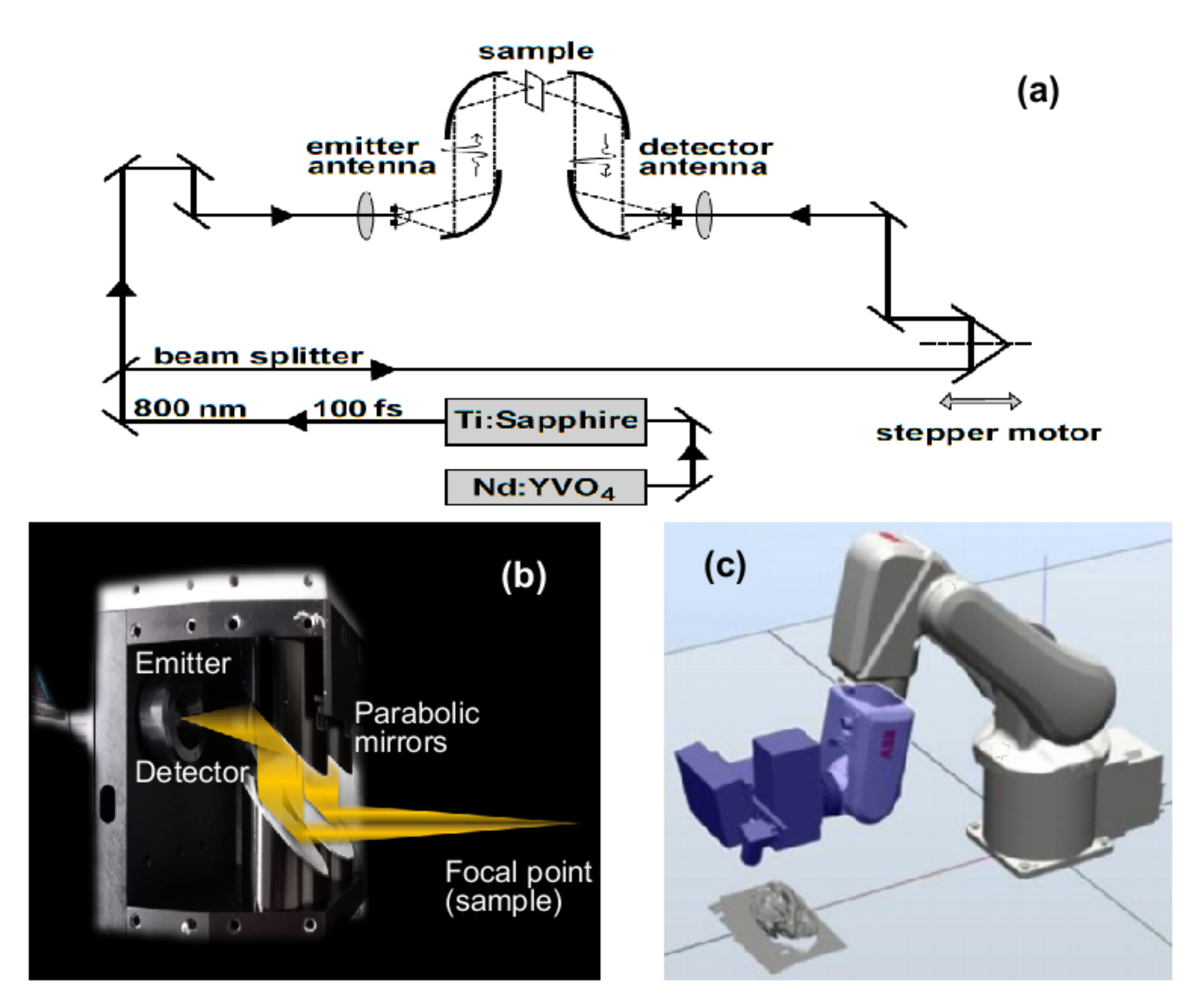
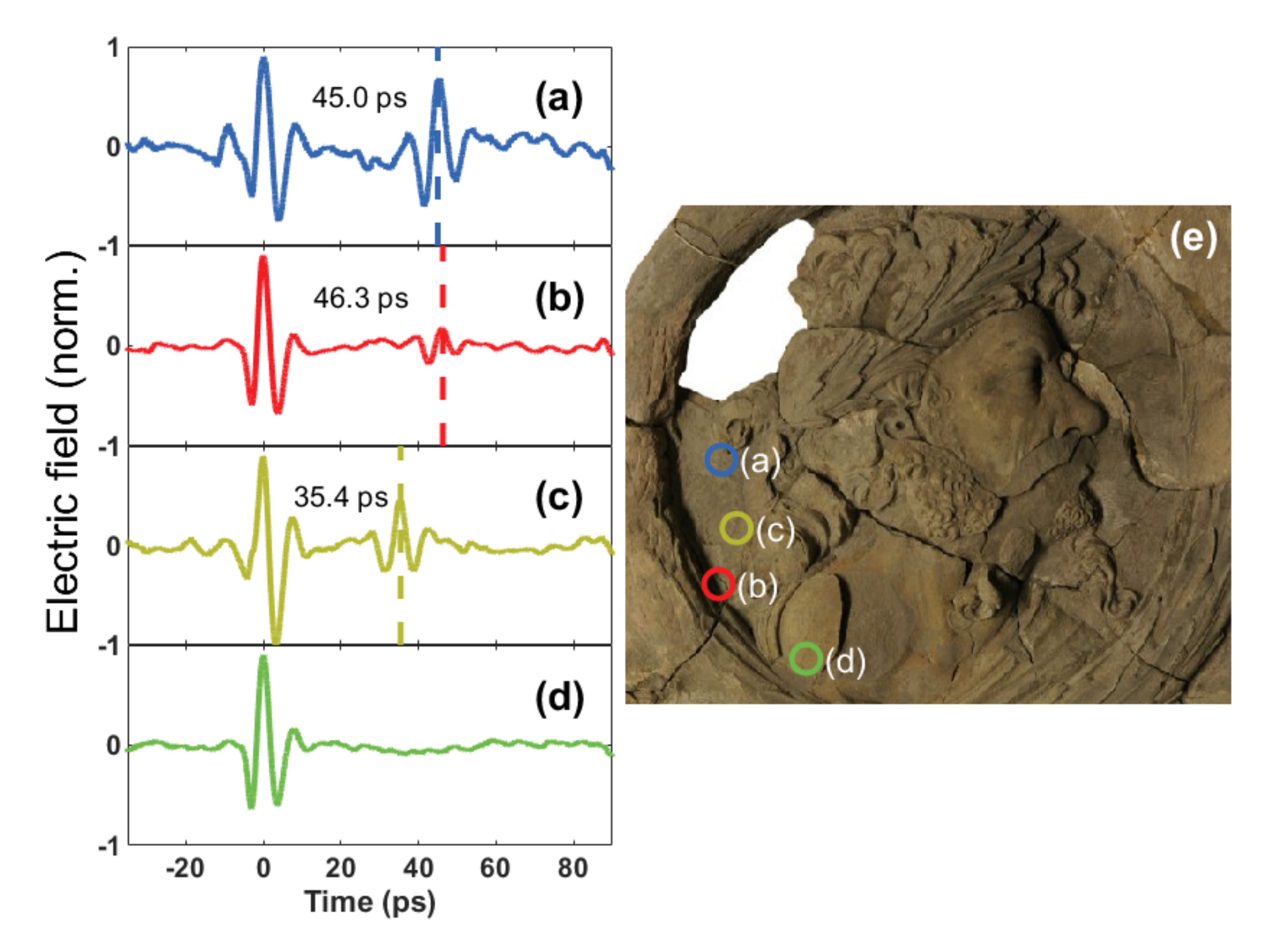
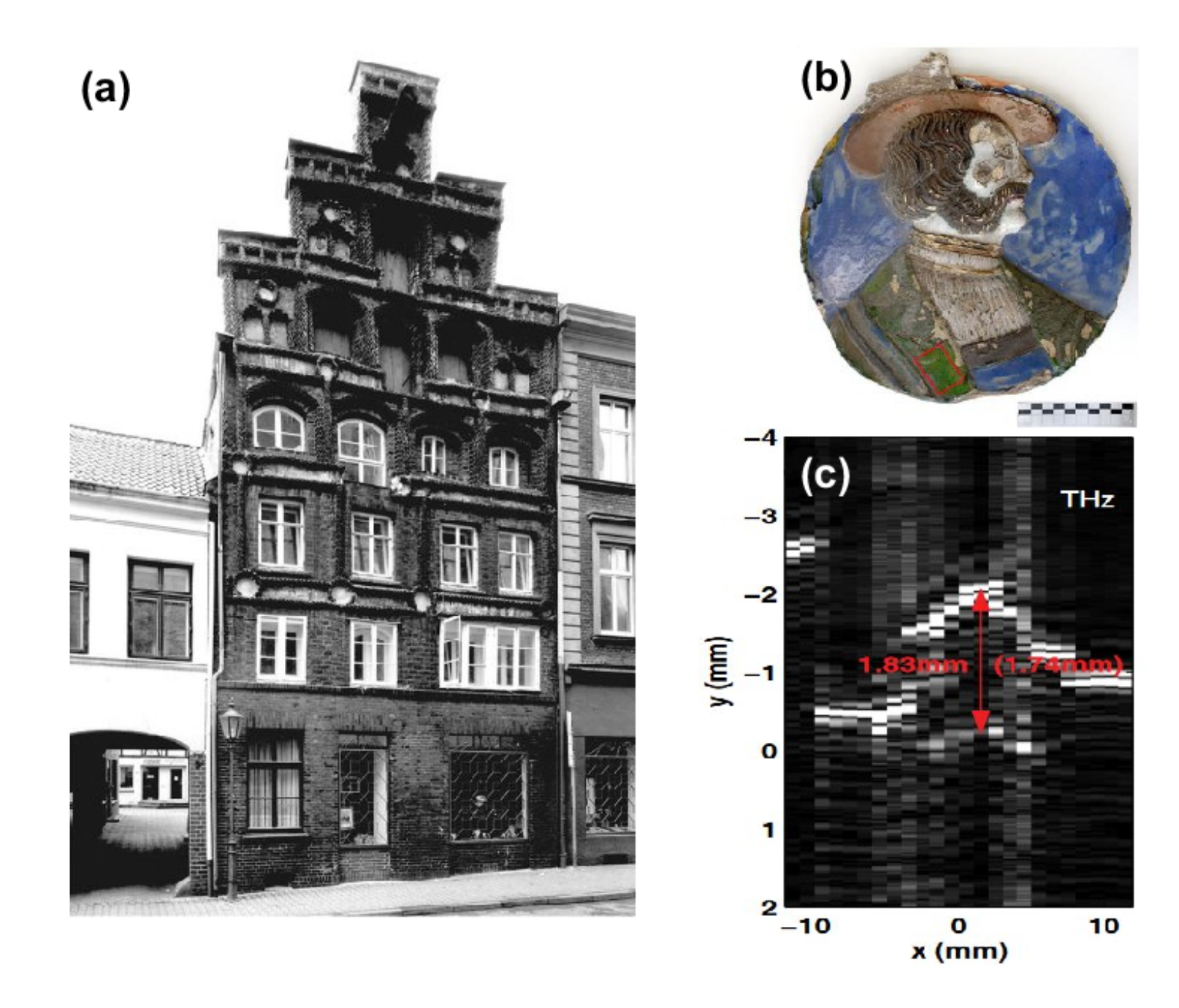
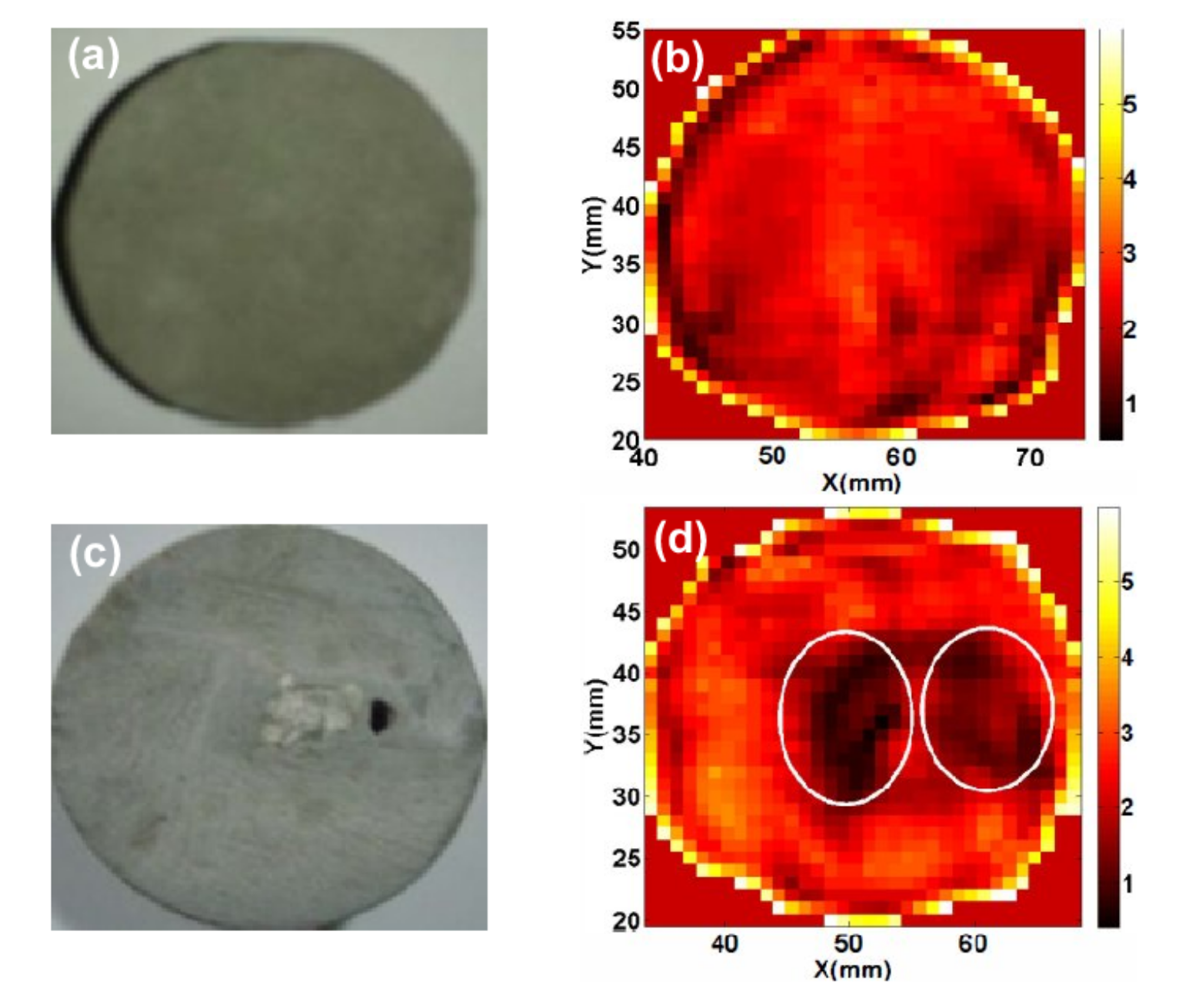
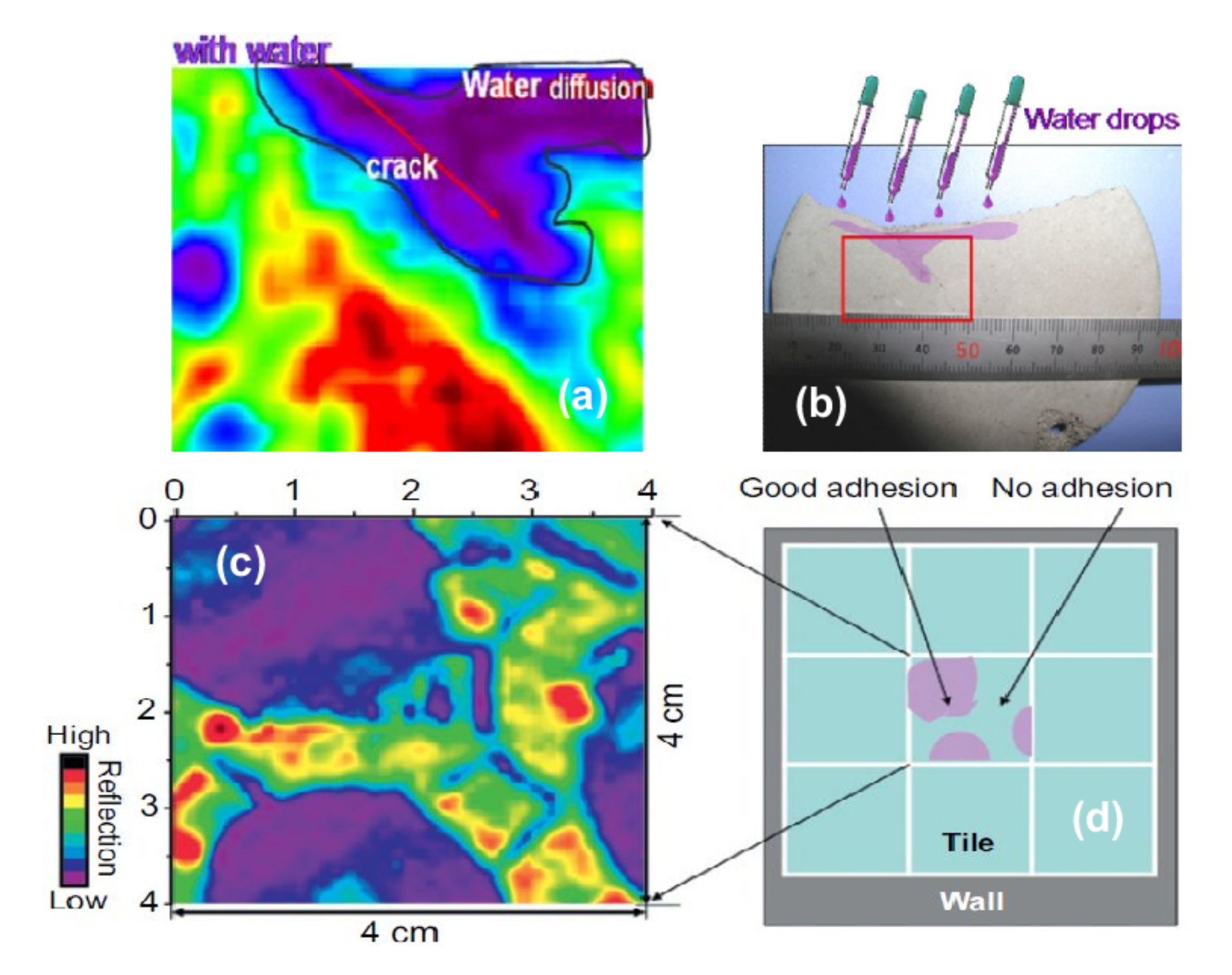
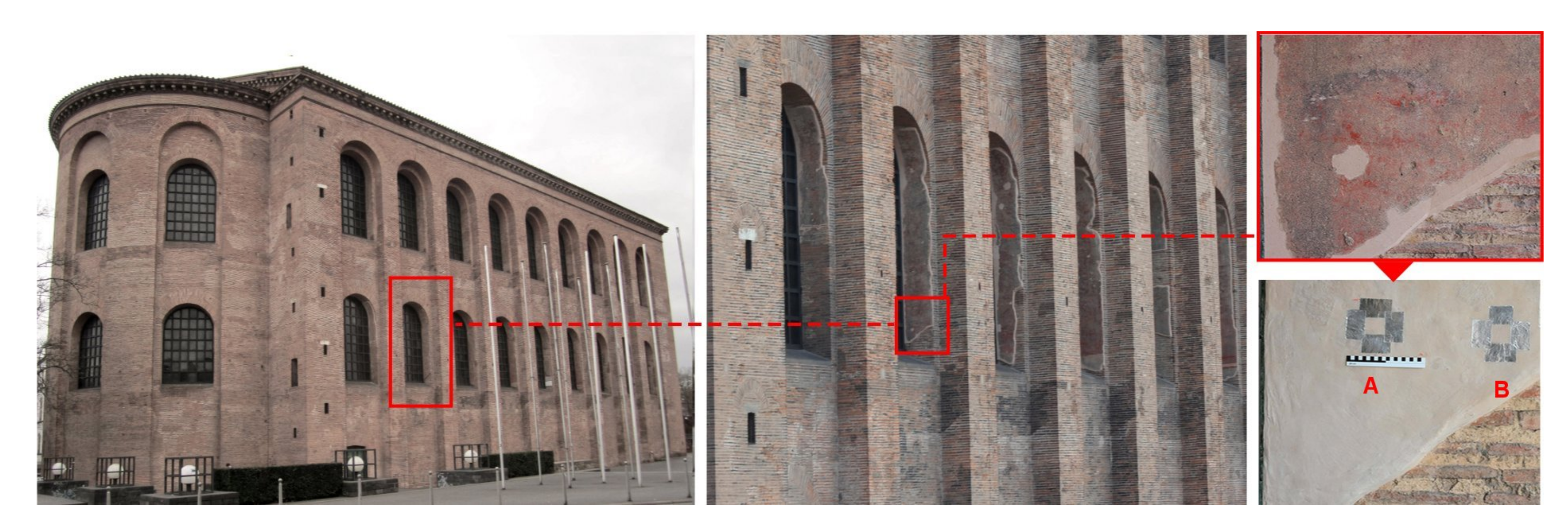

© 2020 by the authors. Licensee MDPI, Basel, Switzerland. This article is an open access article distributed under the terms and conditions of the Creative Commons Attribution (CC BY) license (http://creativecommons.org/licenses/by/4.0/).
Share and Cite
Krügener, K.; Ornik, J.; Schneider, L.M.; Jäckel, A.; Koch-Dandolo, C.L.; Castro-Camus, E.; Riedl-Siedow, N.; Koch, M.; Viöl, W. Terahertz Inspection of Buildings and Architectural Art. Appl. Sci. 2020, 10, 5166. https://doi.org/10.3390/app10155166
Krügener K, Ornik J, Schneider LM, Jäckel A, Koch-Dandolo CL, Castro-Camus E, Riedl-Siedow N, Koch M, Viöl W. Terahertz Inspection of Buildings and Architectural Art. Applied Sciences. 2020; 10(15):5166. https://doi.org/10.3390/app10155166
Chicago/Turabian StyleKrügener, Kirsti, Jan Ornik, Lorentz M. Schneider, Alexander Jäckel, Corinna L. Koch-Dandolo, Enrique Castro-Camus, Nicole Riedl-Siedow, Martin Koch, and Wolfgang Viöl. 2020. "Terahertz Inspection of Buildings and Architectural Art" Applied Sciences 10, no. 15: 5166. https://doi.org/10.3390/app10155166
APA StyleKrügener, K., Ornik, J., Schneider, L. M., Jäckel, A., Koch-Dandolo, C. L., Castro-Camus, E., Riedl-Siedow, N., Koch, M., & Viöl, W. (2020). Terahertz Inspection of Buildings and Architectural Art. Applied Sciences, 10(15), 5166. https://doi.org/10.3390/app10155166




